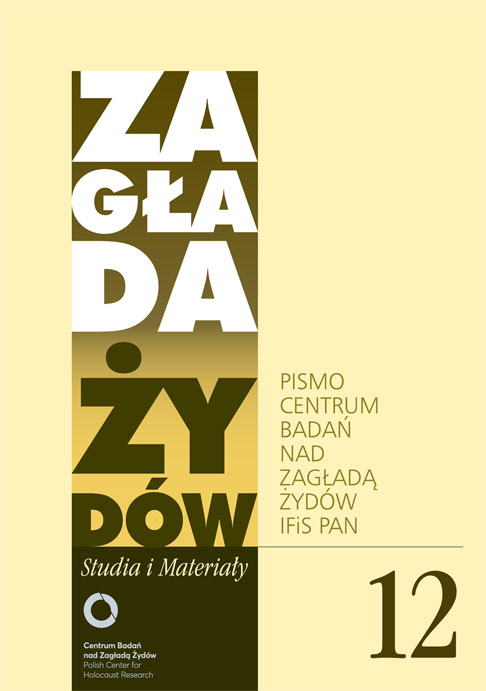Frankenstein w warszawskim getcie. Historia i legenda
Zagłada Żydów. Studia i Materiały, Nr 12 (2016), Strony: 187-208
Data zgłoszenia: 2020-10-19Data publikacji: 2016-11-30
 https://doi.org/10.32927/ZZSiM.414
https://doi.org/10.32927/ZZSiM.414
Abstrakt
The article deals with one exceptionally violent German perpetrator who was part of the occupation force in Warsaw during the Second World War. Inside the Ghetto he maltreated and killed a large number of women, children and men for his own personal pleasure. He did this to such an extensive degree that the population perceived him as monstrous being that was given the nickname „Frankenstein”. The article is mainly based on statements in juridical investigations, from the victim as well as from the perpetrator perspective, supplemented with some selected additional sources. Firstly the source corpus will be evaluated, to work out how these historical sources can be used to shed light on „Frankenstein”. This will be followed by an analysis of the actual identity of this perpetrator. It will be shown that he was, contrary to common belief, not necessarily the SS-Rottenführer Josef Blösche but more likely a member of the German Police Battalion 61. In the end the question will be also raised of how it was possible – despite all rules and regulations – that ghetto guards like him behaved like a marauding soldiery.
Słowa kluczowe
getto warszawskie , Zagłada , policja umundurowana , zbrodnie okupacyjne , warty w getcie , batalion policyjny , sprawca , przemoc , strach , terror , życie w getcie
Licencja
Prawa autorskie (c) 2016 Autor & "Zagłada Żydów. Studia i Materiały"

Utwór dostępny jest na licencji Creative Commons Uznanie autorstwa 4.0 Międzynarodowe.
https://creativecommons.org/licenses/by/4.0
Podobne artykuły
- Adam Kopciowski, Szama Grajer – „żydowski król” z Lublina , Zagłada Żydów. Studia i Materiały: Nr 16 (2020)
- Małgorzata Melchior, The Holocaust and Polish-Jewish Relations in Sociological Studies , Zagłada Żydów. Studia i Materiały: 2008: Holocaust Studies and Materials
- Piotr Forecki, Kwietniowe gadanie. Polskie flagi nad gettem , Zagłada Żydów. Studia i Materiały: Nr 10 (2014)
- Marta Janczewska, Dokumenty urzędowo-medyczne jako źródło do badania losu warszawskich Żydów 1939–1941 , Zagłada Żydów. Studia i Materiały: Nr 9 (2013)
- Agnieszka Haska, Julian Eliasz Chorążycki (1885–1943) , Zagłada Żydów. Studia i Materiały: Nr 9 (2013)
- Elżbieta Janicka, Instead of negationism. The symbolic topography of the former Warsaw ghetto vis-à-vis Holocaust narratives , Zagłada Żydów. Studia i Materiały: Nr Holocaust Studies and Materials (2017)
- Marta Tomczok, Religijny kicz holokaustowy. Zarys zjawiska , Zagłada Żydów. Studia i Materiały: Nr 15 (2019)
- Jan Grabowski, Redakcja, From the editor , Zagłada Żydów. Studia i Materiały: 2008: Holocaust Studies and Materials
- Agnieszka Haska, Sprawiedliwi są wśród nas , Zagłada Żydów. Studia i Materiały: Nr 10 (2014)
- Barbara Engelking, Dziennik Pinkusa Blumenfelda , Zagłada Żydów. Studia i Materiały: Nr 20 (2024)
<< < 1 2 3 4 5 6 7 8 9 10 11 12 13 14 15 16 17 18 19 20 21 22 23 24 25 26 27 28 29 30 31 32 33 34 35 36 37 38 39 40 41 42 43 44 45 > >>
Możesz również Rozpocznij zaawansowane wyszukiwanie podobieństw dla tego artykułu.
 English
English
 Język Polski
Język Polski








